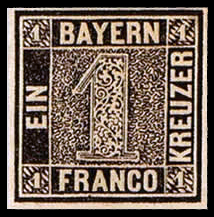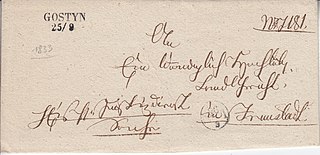

This is an overview of the postage stamps and postal history of the Free City of Danzig .
Contents
Danzig, now Gdańsk, is a Polish city on the Baltic coast. It was the Free City of Danzig with its own stamps from 1920 until 1939.


This is an overview of the postage stamps and postal history of the Free City of Danzig .
Danzig, now Gdańsk, is a Polish city on the Baltic coast. It was the Free City of Danzig with its own stamps from 1920 until 1939.
The first stamps of Danzig were overprinted German stamps issued on 14 June 1920. The first stamps of the Danzig Free State appeared in January 1921 and continued in use until the outbreak of World War II in 1939. [1] At that time the Free City was annexed by Nazi Germany.

A Polish Post Office operated in the harbour of Danzig (see Polish Post Office in Danzig). This used Polish stamps overprinted PORT GDANSK.

An overprint is an additional layer of text or graphics added to the face of a postage or revenue stamp, postal stationery, banknote or ticket after it has been printed. Post offices most often use overprints for internal administrative purposes such as accounting but they are also employed in public mail. Well-recognized varieties include commemorative overprints which are produced for their public appeal and command significant interest in the field of philately.
This is a survey of the postage stamps and postal history of Afghanistan.

Gdańsk is one of the oldest cities in Poland. Founded by the Polish ruler Mieszko I in the 10th century, the city was for a long time part of Piast state either directly or as a fief. In 1308 the city became part of the Monastic State of the Teutonic Knights until 1454. Thereafter it became part of Poland again, although with increasing autonomy. A vital naval city for Polish grain trade, it attracted people from all over the European continent. The city was taken over by Prussia during the Second Partition of Poland in 1793 and subsequently lost its importance as a trading port. Briefly becoming a free city during Napoleonic Wars, it was again Prussian after Napoleon's defeat, and later became part of the newly created German Empire.

The Free City of Danzig was a city-state under the protection and oversight of the League of Nations between 1920 and 1939, consisting of the Baltic Sea port of Danzig and nearly 200 other small localities in the surrounding areas. The polity was created on 15 November 1920 in accordance with the terms of Article 100 of the 1919 Treaty of Versailles after the end of World War I.
Alfons Flisykowski was a Polish worker of the Polish Post Office in the Free City of Danzig in the years 1923–1939 and a second commander of the defence of the Post Office from the invading Nazi German forces when World War II started on 1 September 1939.
Each "article" in this category is a collection of entries about several stamp issuers, presented in alphabetical order. The entries are formulated on the micro model and so provide summary information about all known issuers.
Each "article" in this category is a collection of entries about several stamp issuers, presented in alphabetical order. The entries are formulated on the micro model and so provide summary information about all known issuers.

The Vatican post office has operated its own postal service and issued its own postage stamps since 1929.

The Defence of the Polish Post Office in Danzig (Gdańsk) was one of the first acts of World War II in Europe, as part of the September Campaign. On 1 September 1939 the Invasion of Poland was initiated by Germany when the battleship Schleswig-Holstein opened fire on the Polish-controlled harbor of Danzig, around 04:45–48 hours. Danzig paramilitaries and police, supported by Germany, immediately joined the offensive to take full control of the city, by capturing the Polish post office. Polish personnel defended the building for some 15 hours against assaults by the SS Heimwehr Danzig, local SA formations and special units of Danzig police. All but four of the defenders, who were able to escape from the building during the surrender, were sentenced to death by a German court martial as illegal combatants on 5 October 1939, and executed.

This is a survey of the postage stamps and postal history of Lithuania.

This is a survey of the postage stamps and postal history of Germany and philatelically related areas. The main modern providers of service were the Reichspost (1871–1945), the Deutsche Post under Allied control (1945–1949), the Deutsche Post of the GDR (1949–1990), the Deutsche Bundespost (1949–1995), along with the Deutsche Bundespost Berlin (1949–1990), and are now the Deutsche Post AG.

Germania stamps are definitive stamps that were issued by the German Empire and the Weimar Republic between 1900 and 1922, depicting Germania. They represent the longest running series in German philately and are in their many variations and derivations an essential part of German philatelic collections.
The Fischer Catalogue of Polish stamps is a yearly publication in catalogue form of postage stamps relating to Poland.
The Ruch catalog of postage stamps of Poland, officially titled Ilustrowany Katalog Znaczków Polskich, contained detailed information on Polish postage stamps, and was published on a yearly basis.

Postal history in the territory that now constitutes Latvia began during the 13th century, when the Archbishopric of Riga was included to the area of postal operations of the Monastic state of the Teutonic Knights and the Hanseatic League. In 1580 the Hanseatic League issued their first known regulations on courier work and payroll, regulations that also were active in the territory that now constitutes Latvia.

Poczta Polska, the Polish postal service, was founded in 1558 and postal markings were first introduced in 1764. The three partitions of Poland in 1772, 1793 and 1795 saw the independent nation of Poland disappear. The postal services in the areas occupied by Germany and Austria were absorbed into those countries' postal services. In 1772 the area occupied by Austria was created into the Kingdom of Galicia, a part of the Austrian Empire. This lasted till 1918. The Duchy of Warsaw was created briefly, between 1807 and 1813, by Napoleon I of France, from Polish lands ceded by the Kingdom of Prussia under the terms of the Treaties of Tilsit. In 1815, following Napoleons' defeat in 1813, the Congress of Vienna, created Congress Poland out of the Duchy of Warsaw and also established the Free City of Kraków. Congress Poland was placed under the control of Russia and the postal service was given autonomy in 1815. In 1851 the postal service was put under the control of the Russian post office department regional office in St Petersburg. In 1855 control was restored for a while to the Congress Kingdom but following the uprising in 1863 again came under Russian control from 1866 and continued until World War I. In November 1918 the Second Polish Republic was created.

This is a survey of the postage stamps and postal history of Czechoslovakia.

The Polish Post Office in the Free City of Danzig was created in 1920 and operated until the German invasion of Poland that marked the beginning of World War II.
The following is a timeline of the history of the city of Gdańsk, Poland.
Ministry of Post and Telegraphs was a ministry in the Second Polish Republic. It existed in 1919–1924 and 1927–1939, when it was dissolved because of the Invasion of Poland. In July 1944, the MPiT was recreated by the Polish Committee of National Liberation, under the name Ministry of Communications, Post and Telegraphs, and in November 1944, its pre-war name was reintroduced. On March 11, 1955, the MPiT was renamed into Ministry of Communications.